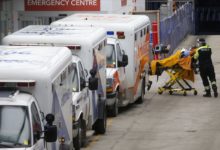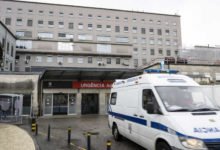Half of Scarborough ICU patients have COVID-19 as vulnerable workers, families bear brunt of pandemic

The man arrived at the emergency department gasping for breath.
It was November, and for several months, Scarborough Health Network emergency physician Dr. Lisa Salamon had seen this kind of patient over and over.
He was in his mid-60s, with pre-existing health conditions, including diabetes, and dangerously low oxygen levels — with such shortness of breath that he struggled to talk, forcing Salamon to call his family to learn his medical history.
It was clear the man had COVID-19, Salamon recalled, and was going to need a ventilator to keep him alive.
“That’s a typical patient that’s going straight to the ICU,” she said.
The hospital system in Toronto’s Scarborough neighbourhood has been flooded with COVID-19 patients during the pandemic’s second wave, with nearly half the total number of intensive care patients across the area’s three hospital sites now battling the illness.
In contrast, less than 20 per cent of the total number of intensive care patients at hospitals elsewhere in Toronto have COVID-19, according to a CBC News analysis.
“We’re seeing a huge number of patients with COVID, both in our COVID assessment centers, and in the emergency department,” Salamon said.
“Some of the other hospitals aren’t seeing nearly the same volume of COVID patients that we’re seeing.”
Certain communities ‘vulnerable’
That influx of patients in Scarborough’s hospitals is a reflection of what’s happening in the community on the east end of Toronto, with both clinicians and advocates citing the virus’ ability to spread through lower-income and racialized neighbourhoods typically featuring more essential workers and multigenerational homes.
“All of those factors have compounded for making certain communities more vulnerable,” explained Neethan Shan, executive director of the Urban Alliance on Race Relations.
“But COVID isn’t the reason these things are happening; the racial inequities existed prior to COVID.”
As of Monday, the Scarborough Health Network’s three ICU sites — at Scarborough General, Centenary and Birchmount hospitals — were treating 29 people with COVID-related critical illness, making up 48 per cent of all their ICU patients.
That’s compared to 81 in total spread out throughout nearly a dozen other hospitals in Toronto, which equates to 18 per cent of the current ICU admissions across the rest of the city.
The figures come from an analysis of the census report from Critical Care Services Ontario, which is provided every morning to critical care stakeholders in Ontario’s hospital system.
Though the latest report is just one snapshot in time, Scarborough ICUs have been “really active” with COVID-19 patients since the first wave, said Dr. Martin Betts, medical director of the critical care program at Scarborough Health Network.
“The people that I’m seeing are not necessarily unhealthy people, but they are at risk of developing really horrific illness — and tragic illness — as a result of this pandemic,” he said.
“And it has less to do with themselves and their health that contributes to the severity of their illness and a lot to do with their work situation, their family life situation, and what they’re exposed to on a daily basis.”
On at least three occasions during the pandemic, Betts said his team has cared for multiple family members with COVID-19 all at once.
At one point in the spring, a husband and wife were both hospitalized with severe COVID-19 and ended up being sent from Scarborough’s Birchmount site to Toronto General for a last-resort form of life support.
The couple had two kids, ages 10 and 18, with the elder teen suddenly forced to take on child care while communicating with nurses and social workers.
“And we’ve had lots and lots of moments like that,” Betts said.
High test positivity in northeast Scarborough
Shan, who is the chief executive officer of Tamil Civic Action and a Scarborough resident himself, said there are layers of inequalities behind those trends.
Extended families are often living together for support or because of the challenges finding affordable housing, he explained, while many essential workers are often lower-income, precariously employed, and more wary of taking sick days — if they’re even available.
“People are fearful … they want to protect themselves,” he said.
“But after a few months have passed, it’s given them no choice but to go back to working in conditions that are unsafe, in retail, and trucking, and so forth.”

Standing in Seasons Park, a greenspace near his home in Scarborough’s northeast corner, Shan noted the area is among the top spots for COVID-19 tests coming back positive in all of Ontario, but lacks strong community-based health supports.
During the last week of November, the area — identified by the postal code digits M1X — had the highest test positivity for the entire province at more than 20 per cent.
The latest available data from the Institute for Clinical Evaluative Sciences (ICES), a non-profit health research institute, shows that postal code region was still fourth-highest by the first week of December with a test positivity of nearly 16 per cent.
While there’s clearly high levels of virus transmission still happening in those hot-spots —not only in Scarborough but also other pockets in Toronto’s northwest end and parts of Peel region — Dr. Jeff Kwong, a family physician and scientist with ICES, said the shifting numbers could be showing a clearer picture based on increased testing.
“It’s just a matter of whether there’s enough testing going on and if there’s not enough testing in a lot of cases, the test positivity definitely goes up,” he explained.
‘Not out of the woods yet’
Toronto’s board of health chair, Joe Cressy, said an ongoing challenge throughout the pandemic has been the hesitancy among some community members to get tested in areas like northeast Scarborough, prompting the city to push for more pop-up sites and support.
“In some cases we’re hearing from newcomer communities that have distrust in government. In some cases we have frontline workers who don’t have adequate sick leave provisions and worry if they test positive, they won’t be able to afford to pay their rent or put food on the table,” Cressy explained.
“And we hear other comments of, ‘If I test positive, will I be sent to an institution?'”
Toronto Public Health is striving to offer more testing options, he continued, with “boots on the ground” from local agencies to address resident concerns in a variety of languages.
Those efforts are one piece of the board of health’s COVID-19 Equity Action Plan, just approved on Monday, which also highlights the need for community outreach to facilitate safe isolation for families, food security and digital access programs, and increased capacity on busy bus routes to reduce crowding.
Calls are also growing from advocates and organizations like the Ontario Nonprofit Network for paid sick leave to better support essential workers beyond the federal government’s Canada Recovery Sickness Benefit, which offers $1,000 of support to workers with COVID-19 over two weeks.
While those efforts may be in motion, and a vaccine for COVID-19 is now rolling out to priority groups in Ontario, the concern for clinicians in Scarborough is how many vulnerable community members will wind up critically ill before the pandemic winds down.
Salamon and Betts said some of the ICU patients they remember treating — the man in his mid-60s for Salamon, and the two critically ill parents for Betts — did, thankfully, survive their illnesses. But plenty of others didn’t and there’s a constant, steady flow of new admissions.
“Every day I’m seeing someone else with really severe illness from COVID that’s presenting to our hospital, presenting to our ICU,” said Betts.
“We know we’re not out of the woods yet.”








Redes Sociais - Comentários